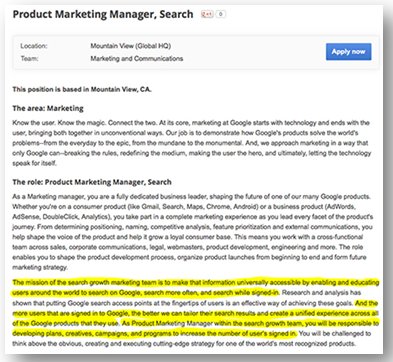At first, I thought this was nothing more than a minor annoyance, but then I learned that Google recently placed a job ad with a description specifically aimed at driving up user sign-in rates. Brian Ussery discovered the listing and reported his findings on his personal blog. The most interesting part of the story, however, is Brian’s uuber-provocative write-up dissecting Big G’s motives.
Looking at the Listing
Brian was smart enough to grab the following screenshot before the Google listing disappeared into the Internet abyss:

It’s a little small, so here’s a close-up of the portion Brian highlighted above:
“The mission of the search growth marketing team is to make that information universally accessible by enabling and educating users around the world to search on Google, search more often, and search while signed-in. Research and analysis has shown that putting Google search access points at the fingertips of users is an effective way of achieving these goals. And the more users that are signed in to Google, the better we can tailor their search results and create a unified experience across all of the Google products that they use.”
Long story short, Google’s so hungry to get you signed in that the company’s willing to pay someone good money to figure out how to convince you. And do you blame ‘em? If you’re signed in, then Google gets the juicy insider info needed to provide super-personalized search results for you, and (as Brian points out) better target ads. Google+, he notes, is a major component of the search giant’s sign-in plan. However, much to the company’s chagrin, the social network has nowhere near the viral likability of rivals such as Facebook and Twitter. G+ is growing, yes, but most of the people who use the service do so for the business benefits alone.
Google’s Catch-22
As Brian pointed out in his post, Google has a serious setback hindering its growth: rival social networks block G from accessing their astronomical database of user-generated content. This lockout is detrimental to Big G’s bottom line. The majority of the blocked content contains valuable personal info that Google would love to use in order to serve relevant ads.
Hence, Google+ jumped to the top of G’s list of priorities. Although the company has a much greater audience reach than Facebook, Facebook has exponentially more personal data on each member. Google+ is a way for Big G to counteract this problem by harvesting more personal data from searchers than it could uncover otherwise.
But Google’s still waiting for that goldmine. James Whittaker, a former development director for Google, wrote about the company’s new direction in a blog post manifesto defending his decision to leave. James grew frustrated with G’s shift from innovator to relentless competitor, and he noted this about the company’s push to make G+ a success:
“A user exodus from Facebook never materialized. I couldn’t even get my own teenage daughter to look at Google+ twice, “social isn’t a product,” she told me after I gave her a demo, “social is people and the people are on Facebook.” Google was the rich kid who, after having discovered he wasn’t invited to the party, built his own party in retaliation. The fact that no one came to Google’s party became the elephant in the room.”
Obviously, Google needed to do something bold to make G+ catch on. The answer? Tie all Google’s offerings together under the umbrella of a verified Google account and focus on forcing sign-ins.
Google: Multiple Services, One Goal
Last January, ZDNet reported that Google was testing the idea of automatically creating a Gmail account and a Google+ profile for people who set up new Google accounts. The author updated the post in November, stating that Google began a full-scale (and very hush-hush) rollout of the new automatic signup feature. This is the statement G’s PR people issued when questioned about the quiet new change:

If you’ve signed up for a Google account any time during the last year or so, you have a Gmail account and a Google+ profile – whether or not you decide to use it. But Google’s not stopping there. According to Google Support, if you want to use Google Play on any of your mobile devices, you’ll need a Google account for that as well. Plus, you’ll need a Google Wallet account tied to your Google account if you want to buy apps or any other paid content.
See what they did there? Google is slowly filling in every possible escape hatch for users who want to avoid signing in. That’s their answer to their whole “lack of personal user data” conundrum. G’s given up on trying to entice you to use its services – the search titan has opted to pursue the easy route instead: leveraging its reach and Internet domination to penetrate every aspect of your online life and quite literally force your hand.
Article by Nell Terry, a post in SPN
Google – One Way or the Other, We’re Gonna Get YOU